
The House of Bourbon is a dynasty that originated in the Kingdom of France as a branch of the Capetian dynasty, the royal House of France. Bourbon kings first ruled France and Navarre in the 16th century. A branch descended from the French Bourbons came to rule Spain in the 18th century and is the current Spanish royal family. Further branches, descended from the Spanish Bourbons, held thrones in Naples, Sicily, and Parma. Today, Spain and Luxembourg have monarchs of the House of Bourbon. The royal Bourbons originated in 1272, when Robert, the youngest son of King Louis IX of France, married the heiress of the lordship of Bourbon. The house continued for three centuries as a cadet branch, serving as nobles under the direct Capetian and Valois kings.
The Most Serene House of Bourbon-Condé, named after Condé-en-Brie, was a French princely house and a cadet branch of the House of Bourbon. The name of the house was derived from the title of Prince of Condé that was originally assumed around 1557 by the French Protestant leader Louis de Bourbon (1530–1569), uncle of King Henry IV of France, and borne by his male-line descendants.
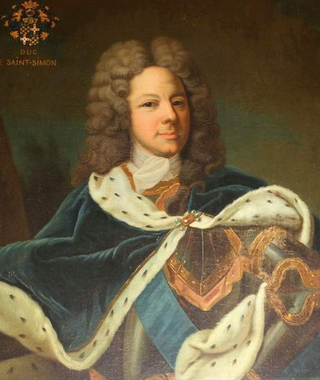
Louis de Rouvroy, duc de Saint-Simon, GE, was a French soldier, diplomat, and memoirist. He was born in Paris at the Hôtel Selvois, 6 rue Taranne. The family's ducal peerage (duché-pairie), granted in 1635 to his father Claude de Rouvroy (1608–1693), served as both perspective and theme in Saint-Simon's life and writings. He was the second and last Duke of Saint-Simon.
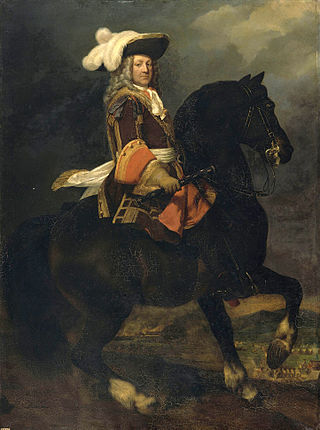
Louis Joseph de Bourbon, Duke of Vendôme, often simply called Vendôme was a French general and Marshal of France. One of the great generals of his era, he was one of Louis XIV's most successful commanders in the War of the Grand Alliance and War of the Spanish Succession.

The 4th House of Orléans, sometimes called the House of Bourbon-Orléans to distinguish it, is the fourth holder of a surname previously used by several branches of the Royal House of France, all descended in the legitimate male line from the dynasty's founder, Hugh Capet. The house was founded by Philippe I, Duke of Orléans, younger son of Louis XIII and younger brother of Louis XIV, the "Sun King".

Louis Jean Marie de Bourbon was the son of Louis Alexandre de Bourbon and his wife Marie Victoire de Noailles. He was therefore a grandson of Louis XIV of France and his mistress, Madame de Montespan. From birth he was known as the Duke of Penthièvre. He also possessed the following titles: Prince of Lamballe ; Prince of Carignano; Duke of Rambouillet; Duke of Aumale (1775); Duke of Gisors; Duke of Châteauvillain; Duke of Arc-en-Barrois; Duke of Amboise; Count of Eu; Count of Guingamp. He was the father in law of Philippe Égalité.

The Château d'Anet is a château near Dreux, in the Eure-et-Loir department in northern France, built by Philibert de l'Orme from 1547 to 1552 for Diane de Poitiers, the mistress of Henry II of France. It was built on the former château at the center of the domains of Diane's deceased husband, Louis de Brézé, seigneur d'Anet, Marshal of Normandy and Master of the Hunt.

Philippe, Grand Prior of Vendôme (1655–1727) was a French general, a grand prior of France in the order of Malta, as well as an epicurian and a libertine.
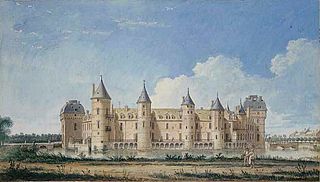
La Ferté-Vidame is a commune in the Eure-et-Loir department in northern France.

The House of Bourbon-Penthièvre was an illegitimate branch of the House of Bourbon, thus descending from the Capetian dynasty. It was founded by the duc de Penthièvre (1725–1793), the only child and heir of the comte de Toulouse, the youngest illegitimate son of Louis XIV of France and the marquise de Montespan, and his wife, Marie Victoire de Noailles, the daughter of Anne Jules de Noailles, duc de Noailles.

A prince du sang or prince of the blood is a person legitimately descended in male line from a sovereign. The female equivalent is princess of the blood, being applied to the daughter of a prince of the blood. The most prominent examples include members of the French royal line, but the term prince of the blood has been used in other families more generally, for example among the British royal family and when referring to the Shinnōke in Japan.
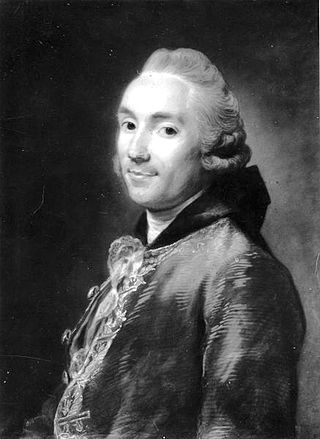
Jean Joseph de Laborde, Marquis of Laborde was a French businessman, slave trader, fermier général and banker to the king, who turned politician. A liberal, he was guillotined in the French Revolution. Though legally a Marquis he rarely used his title.
Under the Ancien Régime, the goods of the House of Orléans comprised two distinct parts : the apanage and the "biens patrimoniaux".

The Principality of Sedan was an independent Protestant state centered on the Château de Sedan in the Ardennes. It was ruled by the Prince of Sedan, who belonged to the noble La Marck and La Tour d'Auvergne families. The Princes of Sedan asserted and acquired recognition of their sovereignty gradually between the 1520s and 1580s by means of adopting the princely title, minting coin, legislating and signing treaties. In 1641, during the Thirty Years' War, the Prince submitted to France and his principality was occupied the following year. In 1651 the reduced principality was exchanged for other lands in France and was annexed to the crown.
Jean de Ferrières (1520–1586), Vidame de Chartres, Seigneur de Maligny, was an influential Huguenot in the French Wars of Religion in the 16th century. He died a prisoner in a galley, unable to pay his ransom, and was succeeded by his nephew, Pregent de La Fin.
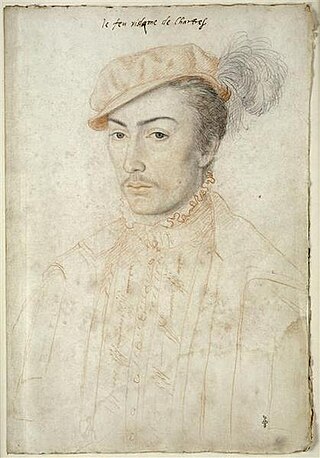
François de Vendôme, Vidame de Chartres, was a successful soldier and glamorous courtier who figures in accounts of the brilliant but decadent French court of the 1550s.

Duke of Cars is a French noble title that was first created in 1816.

















